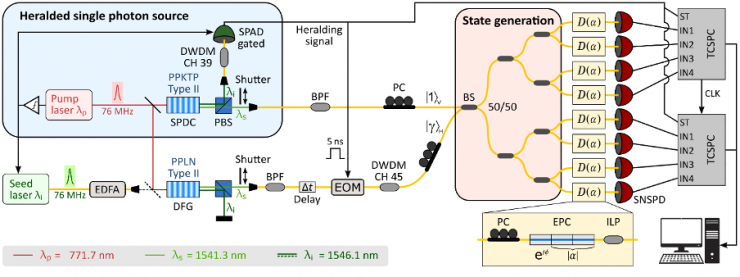Local and scalable detection of genuine multipartite single-photon path entanglement
Patrik Caspar, Enky Oudot, Pavel Sekatski, Nicolas Maring, Anthony Martin, Nicolas Sangouard, Hugo Zbinden, Rob Thew
Quantum 6, 671 (2022)
A collaborative effort between: the Quantum Technologies and Quantum Theory groups in Geneva, and researchers from the Quantum Information Theory groups of ICFO in Barcelona and the University Paris Saclay.
You can read the full article here.
The generation, distribution and certification of entanglement in multipartite quantum communication networks is of increasing importance as the size and complexity of networks grow beyond simple short-distance point-to-point scenarios. In general, multipartite entanglement enables applications such as enhanced sensing or multi-user quantum communication protocols. At the heart of the matter, the challenge is to find scalable solutions which still remain experimentally feasible in order to realise these applications.

Experimental schematic for the detection of an 8-partite single-photon path-entangled state
Regarding the generation and distribution of entanglement for quantum repeaters, a shift away from photon-pair and towards heralded single-photon entanglement has already provided significant scaling benefits, even for point-to-point communication schemes. More interestingly, the single-photon approach can be efficiently extended to the distribution of entanglement between multiple parties; however, the certification of entanglement in a multipartite scenario is extremely challenging. Beyond tomography, which exhibits exponential scaling with the number of parties involved, even typical entanglement witnesses require multiple settings per party.
In this work we developed an entanglement witness, tailored to the W state, to reveal genuine multipartite entanglement. The witness is scalable as it only requires two different measurement settings, independent of the number of parties. Its applicability is demonstrated in an experiment where genuine 8-partite path-entangled states are heralded at high rates and successfully certified by the presented witness.
Previous works on the topic either relied on certification methods that required the recombination of the optical modes held by the different parties (S. Papp et al. 2009, M. Gräfe et al. 2014) and are therefore not applicable in distributed scenarios, or used an entanglement witness whose number of measurement settings still scaled quadratically with the number of parties involved (F. Monteiro et al. 2015).
The witness developed in this work is therefore well suited for efficient certification of multipartite single-photon path entanglement in future quantum networks. For example, highly entangled multipartite states could be distributed at high rates in a scheme where each party holds a photon-pair source and one photon of each pair is sent to a central multi-port beam splitter that erases the which-path information. In this way, local losses can be kept low and the added distance between parties only reduces the heralding rate. In combination with quantum memories, such a scheme has potential applications relying on distributed W states. The experimental challenge in such a scheme, however, remains the need for phase stability in long fibre links.